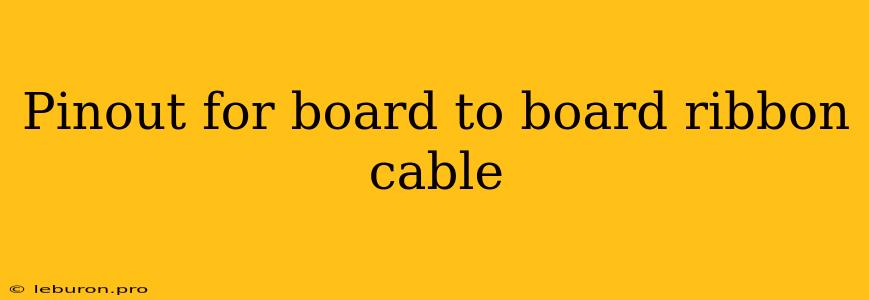The intricate world of electronics often involves the seamless transmission of data and power between different components, and a common solution for this is the pinout for board to board ribbon cable. These cables, with their flat and flexible nature, offer a versatile and reliable method for connecting printed circuit boards (PCBs) in various applications. Understanding the pinout for board to board ribbon cable is crucial for ensuring proper connectivity and functionality, and this article will delve into the essential aspects of this pinout process.
Understanding Board to Board Ribbon Cables
Before diving into pinout for board to board ribbon cable specifics, let's first understand the fundamental characteristics of these cables. Board to board ribbon cables are typically comprised of multiple insulated wires bundled together in a flat, ribbon-like configuration. These wires are arranged in parallel and connected to a header or connector on each end. The header, often a plastic or metal component, provides a secure interface for mating with the corresponding connectors on the PCBs.
Key Features of Board to Board Ribbon Cables:
- Flexibility: The flat, ribbon-like design offers flexibility, making it easier to route cables in tight spaces or through bends.
- Ease of Assembly: The parallel arrangement of wires simplifies the assembly process, as it allows for quick and easy connection.
- Cost-Effectiveness: These cables are generally cost-effective, especially compared to other cable types.
- Multiple Wire Counts: Ribbon cables come in various wire counts, enabling customized solutions for different applications.
- Signal Integrity: Proper pinout for board to board ribbon cable is essential for maintaining signal integrity, ensuring reliable data transmission.
The Importance of Pinout
Pinout for board to board ribbon cable essentially refers to the arrangement of wires within the ribbon cable and their corresponding connections on the header. This arrangement plays a critical role in ensuring proper communication between connected PCBs.
Why is Pinout Crucial?
- Correct Data Transmission: Each wire in a ribbon cable carries a specific signal or power. The pinout for board to board ribbon cable dictates how these signals are routed and connected to the corresponding pins on the PCBs. Incorrect pinout can lead to miscommunication, data corruption, or even device malfunction.
- Signal Integrity: Proper pinout for board to board ribbon cable helps maintain signal integrity by minimizing crosstalk and interference between wires. This is particularly important for high-speed data transmission where signal quality is paramount.
- Power Delivery: In some applications, ribbon cables are used to carry power between boards. The pinout for board to board ribbon cable must be carefully defined to ensure proper voltage and current distribution to avoid short circuits or component damage.
Deciphering the Pinout
The pinout for board to board ribbon cable is typically documented in a diagram or table. These documents provide a visual or tabular representation of the wire arrangement and their corresponding pin numbers.
Pinout Diagram:
A pinout diagram usually depicts the ribbon cable with its wires arranged in parallel. Each wire is labeled with its corresponding pin number. The diagram often includes a key to identify the signal or power carried by each wire.
Pinout Table:
A pinout table provides a more tabular representation of the pinout information. Each row represents a wire in the ribbon cable, and each column lists the corresponding pin number, signal or power designation, and any other relevant information.
Finding Pinout Information
The specific pinout for board to board ribbon cable will vary depending on the cable type, connector type, and application. To find the correct pinout, you can:
- Refer to the cable documentation: The manufacturer's documentation for the specific cable type should include the pinout information.
- Consult the datasheet: If you are using a standard ribbon cable with common connectors, you can find the pinout information in the datasheet of the connector.
- Contact the manufacturer: If you have difficulties finding the pinout, you can contact the manufacturer of the cable or connector for assistance.
Conclusion
Understanding the pinout for board to board ribbon cable is essential for ensuring proper functionality and reliable communication between PCBs. By carefully referencing the pinout documentation and ensuring correct connections, you can minimize the risk of errors and ensure smooth operation of your electronic devices.
